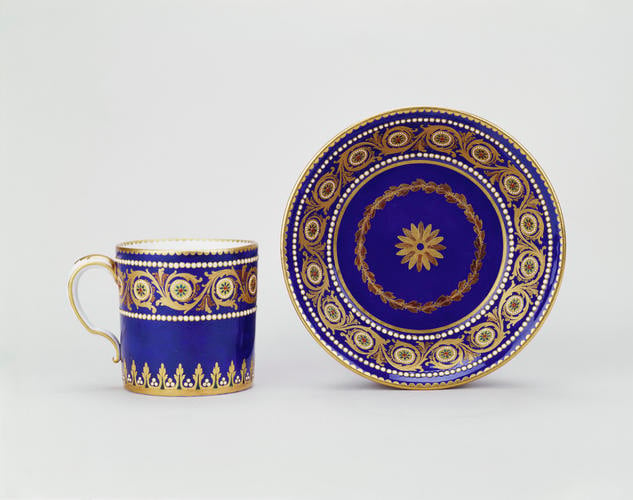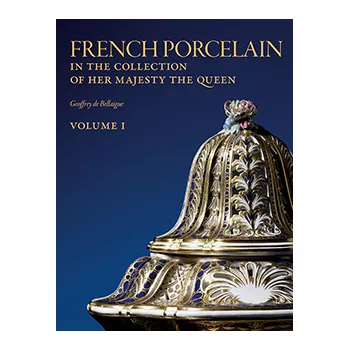Gobelet litron c. 1780-85
Soft-paste porcelain, beau blue ground and gilded decoration | Cup 7.6 x 10.1 x 7.6, saucer 3.6 x 14.9 cm (whole object) | RCIN 58191
-
First produced in 1752, the gobelet litron was a popular model at Vincennes and Sèvres throughout the eighteenth century. The cylindrical cup received its name because of its resemblance to the litron, an old wooden cubic measure of slightly larger dimensions, used to quantify salt, grain, flour and peas.
The gobelet litron was among the earliest ‘useful wares’ produced at the manufactory. Although the vast majority of gobelets litrons were made to be used, some were intended to serve as eye-catching knick-knacks for display on chimneypieces and occasional tables. They were the perfect gift and jewelled cups and saucers were just the sort of eye-catching New Year novelty which would have found favour with courtiers at the end-of-year sales held in the private apartments in Versailles. It is significant, therefore, that 69 of the 128 specifically named jewelled gobelets litrons which passed through the kilns in 1781 were fired in December. In 1782 the same ratio was maintained, 38 out of 66 being fired in the month of December. While matching sets of gobelets litrons were produced to be incorporated into déjeuners and cabarets, others were sold singly, and yet others were grouped together to form sets of contrasting decoration.
Jewelling decoration, which was probably introduced at Sèvres in 1779, was at its most popular during the early years of the 1780s. The process involved the application of drops of enamel in imitation of precious stones (pearls, sapphires, rubies, emeralds, topaz, amethysts, turquoise, etc.) on to gold foils engraved and tooled in shallow relief which had been formed by means of steel dies. Jewelling, which was applied in the eighteenth century to both hard- and soft-paste porcelain, was used at Sèvres in combination with a wide range of ground colours. In addition to dark blue (beau bleu), which was undoubtedly the most popular, they included green, turquoise blue, lapis lazuli, black, merde d’oie (olive green), boue de Paris (?beige), mauve, red, lilac, maroon, as well as white.
Plain gold bands encircle the foot of this cup and of the saucer; others, notched on the interior and exterior, running around the rims of both pieces. A broad arabesque border, which is edged with single rows of white pearls, forms the principal decoration. The scrolls of the arabesques are centred on jewelled paterae composed of a ruby within radiating green petals encircled by white seed pearls and an outer coiled-rope motif forming the rim of the gold foil. Above the foot of the cup is a band of upright acanthus leaves in gold with green spines, alternating with white pearls in clusters of three. In the well of the saucer is a laurel wreath encircling a flower-head, all in two-colour gold.
Examples of dated jewelled Sèvres porcelain cover the period 1779 to 1787. They include tableware, principally cups and saucers, as well as ornamental pieces. The most ambitious commission was a dressing table set (toilette) which Louis XVI presented to Grand Duchess Maria Fedorovna, when she and her husband, the future Emperor Paul I of Russia, were travelling in Austria, Italy and France under the assumed names of the comte and comtesse du Nord. Described at the time as a ‘superbe toilette’, the total cost charged by the manufactory came to the considerable sum of 75,000 livres.
Many of the dies were cut by Jean-Pascal Le Guay, described as cizeleur-graveur de matrices, who was established in the rue Beaubourg in the parish of Saint-Nicolas-des-Champs. In the lists he supplied to the manufactory of the stamps and dies he had engraved for Sèvres during the period 26 June 1780 to the end of 1785 he specifically states that he was copying designs of Jean-Baptiste-Etienne Genest, the head of the painters’ studio. It may well be that Genest designed the patterns for all the dies, probably under the direction of the sculptor Louis-Simon Boizot, who was placed in overall charge of the design of the components making up the comtesse du Nord’s jewelled toilette. Some were evidently sent for approval to the comte d’Angiviller, the minister responsible for the manufactory since 1774. In a letter dated 2 June 1781, d’Angiviller wrote to the Director, Antoine Régnier, informing him that Genest had sent him a drawing of ten new designs for metal dies which were to form an addition to the existing stock.
Jewelling, though it was to prove a passing fashion, found favour with Louis XVI and Marie-Antoinette, as their choice of present for the comtesse du Nord suggests and as their own purchases indicate. They both acquired sets of vases enriched with jewelling. The fashion spread. In the early 1780s demand was such that pieces already decorated were ‘enhanced’ by the addition of strings of pearls and rosettes and by the enrichment of arabesques with pearls and jewelling.
Of all the jewelled cups and saucers still surviving in the Royal Collection this gobelet litron can probably be regarded as the example which most successfully combines traditional gilded decoration with discreetly applied jewelled embellishments.
Text adapted from French Porcelain: In the Collection of Her Majesty The Queen, London, 2009Provenance
In the Royal Collection by 1907
-
Creator(s)
(porcelain manufacturer)(nationality) -
Medium and techniques
Soft-paste porcelain, beau blue ground and gilded decoration
Measurements
Cup 7.6 x 10.1 x 7.6, saucer 3.6 x 14.9 cm (whole object)
Category
Place of Production
Sèvres [France]












